Collecting autumn or fall mushrooms is a pleasure. These mushrooms that grow in fall can be found on stumps in large families and, having found such a family, you can immediately pick up a whole basket. But the main thing in “quiet hunting” is to learn to distinguish edible specimens from false ones.
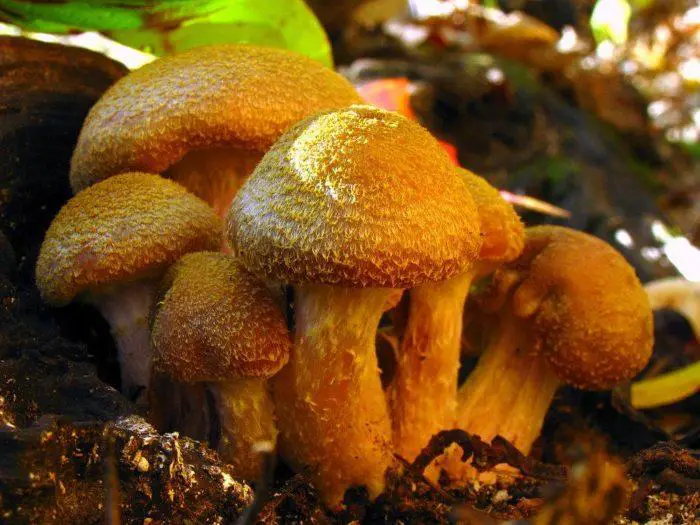
Table of Contents
General information about mushrooms that grow in fall or autumn
Autumn mushroom is one of the most delicious mushrooms. It is found everywhere: from Siberia and the Urals to the Crimea. You can go on a “silent hunt” already in August, and the last harvest of mushrooms can be harvested in November. The mushroom picker grows on old fallen trees, stumps or on the soil around them.
Characteristic of mushrooms that grow in fall
All mushrooms have poisonous counterparts. Recovering into the forest, you need to know what they look like.
All types of mushrooms that grow in fall have several common characteristics:
- The cap diameter is 3-15 cm, depending on the age of the specimen. In young specimens, it is spherical, but becomes prostrate with age, with a characteristic tubercle in the center.
- The color of the skin on the hat is brown-yellow or ocher. A characteristic feature of edible species is the presence of scales on the cap.
- The leg is connected to the hat with a white film, which eventually breaks and forms a ring. It is the presence of a leathery ring on the leg that makes it possible to distinguish poisonous specimens from edible ones. In false species, the leathery ring is completely absent.
- The leg can reach 18 cm in height and 2.5 cm in width. It is dense to the touch, has a cylindrical shape and expands slightly at the bottom.
The pulp is dense, painted in a pleasant white color and does not change color at the break. It has a pleasant mushroom aroma and taste, while inedible specimens have an unpleasant and earthy smell of pulp.
Where do mushrooms grow in fall or autumn?
It is very important to learn how to distinguish real varieties of fall or autumn mushrooms from false ones in appearance since they grow in the same places.
Reference! By itself, any honey agaric is a harmful parasite that settles on trees and often causes dangerous diseases.
Types of mushrooms that grow in fall are found on almost all trees, but especially often form mycorrhiza with birch. Fruiting bodies can form on both living and dead trunks. Mushroom picking is best done in old birch forests with a lot of stumps and old fallen trees. Often they are found in clearings and swampy alder forests. On conifers, these forest gifts are less common.
When they appear
Traditionally, honey agarics are collected in the fall. Peak fruiting occurs in September-October and depends on weather conditions. The period of active growth of fruiting bodies is short, about two weeks, so you should not postpone a trip to the forest.
Edibility of fall mushrooms
Fall mushrooms are delicious mushrooms that can be boiled, fried or frozen. But it is best to roll the harvested crop into jars for the winter.
There is a classic recipe for pickling mushrooms. It will need the following ingredients:
- 2-3 kg honey mushrooms;
- 1 liter of water to prepare the marinade;
- 2 tbsp. l. Sahara;
- 3 art. l. table vinegar (9%);
- 1 tsp Sahara;
- 5 black peppercorns;
- 2 bay leaves.
Preparation of winter preparation is carried out as follows:
- We clean the mushrooms from debris, rinse under running water and cook until tender in salted water.
- Mushrooms will be ready when all the fruiting bodies sink to the bottom of the pan. During the cooking process, foam forms on the surface of the water: it must be constantly removed with a slotted spoon.
- While mushrooms are boiling, in a separate saucepan, mix the ingredients for the marinade (water, salt, sugar, vinegar, and spices).
- We throw the finished mushrooms into a colander and lower them into the boiling marinade and cook after boiling for another 15 minutes. This high-temperature cooking will prevent the jars from bulging or exploding.
We layout the mushrooms boiled in the marinade in sterilized jars and seal them hermetically with lids.
Edible Mushrooms that Grow in Fall or Autumn
Fall or autumn is the best time for lovers of quiet hunting, a real mushroom season. When and what to look for in the forest, how to recognize edible mushrooms and not confuse them with anything.
White Mushroom (Boletus edulis)
The dream of every mushroom picker and one of the most valuable trophies. It is quite common all over the world, the main thing is to know the place.
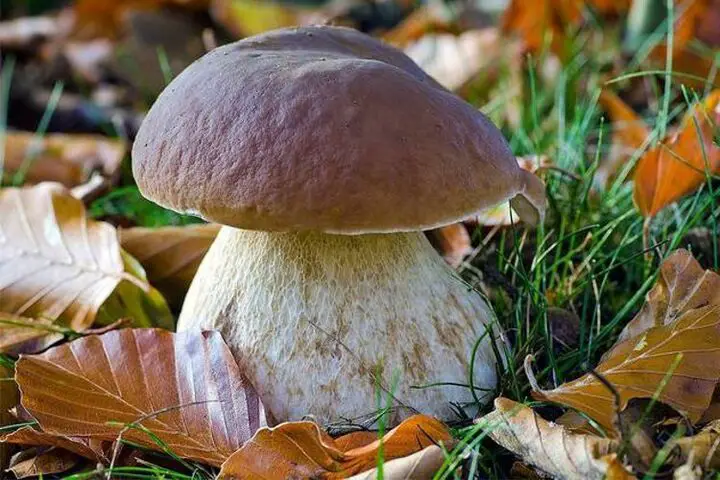
White Mushroom (Boletus edulis) is easy to identify by a rounded slightly convex hat of a reddish-brown, dark orange, and yellowish hue. It reaches a diameter of 30 cm, covered with matte velvety skin, darker in the center and lighter at the edges. After the rain, the hat becomes shiny and a little slippery. The leg of the porcini mushroom is massive, in the form of a mace or a low barrel. It is usually lighter than the cap and covered with a net of greenish veins. In the cut, the porcini mushroom is strong, dense, and juicy, with white flesh and a mild pleasant aroma.
Where does it grow
Favorite habitats are old mixed forests with moderately moist soil. Prefers to grow under oaks, beeches, in spruce-birch thickets, hazel. Often it can be found next to chanterelles and russula.
When to Collect
White Mushroom appears in waves from July to October. The most abundant third wave begins in the second decade of August and lasts until mid-September.
What can be confused
Boletus edulis is similar to white oak and white pine mushroom (boletus), but they are edible counterparts. It is much more dangerous to confuse it with the gall Mushroom (Tylopilus felleus) or the extremely toxic beautiful boletus (Boletus pulcherrimus). They can be distinguished from a real porcini mushroom by its cut: upon contact with air, the flesh of the first gradually turns red, and the second turns blue. In addition, if a small piece of the twin mushroom is carefully placed on the tongue, then bitterness will warn of danger. Real porcini mushroom is not bitter.
At the end of this article, we will offer you use mobile applications that, among other things, will help you visually distinguish edible mushrooms from non-edible ones.
boletus (Leccinum scabrum)
There is probably no mushroom picker who does not know this delicious mushroom with a telling name.
The common boletus (Leccinum scabrum) has a neat semicircular hat 5–15 cm in diameter with a smooth skin of a gray-brown or brownish hue. The second distinguishing feature is a high (up to 15 cm) leg, covered with black scales, resembling a speck from a distance. If the mushroom is broken, you will see white or slightly pinkish flesh. Young boletus are especially good. As they grow older, the pulp loosens and becomes less tasty.
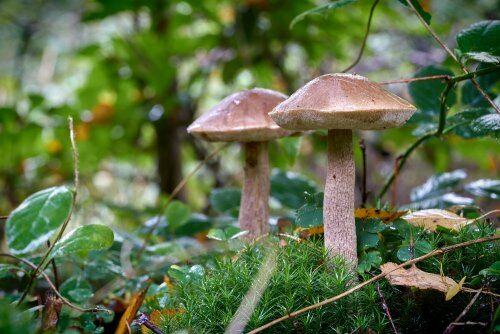
Where does it grow
In mixed and deciduous forests, the main thing is that there are birches nearby. You need to look for a mushroom under the trees and on well-lit forest edges.
When to Collect
Boletus boletus can be harvested all summer and autumn, but the peak of fruiting occurs in August and the first decade of September.
What can be confused
The dangerous twins of Leccinum scabrum include the same inedible gall Mushroom. In order not to confuse them, carefully look at the leg – in the gall Mushroom, it is not covered with scales, but with a brown mesh. The tubular layer is pinkish. On the fault, the gall Mushroom turns red, the boletus does not have this.
Chanterelles (Cantharellus cibarius)
Another favorite of mushroom hunting, which is valued not only for its taste, but also for its benefits – chanterelles contain essential amino acids, are rich in minerals, and have a good effect on vision and metabolism. One of the rare types of mushrooms that are extremely rarely wormy.
The real chanterelle (Cantharellus cibarius), or Cockerel, has a characteristic fruiting body with a short fleshy leg, which smoothly turns into an irregular funnel-shaped hat of bright yellow, sometimes almost orange color. The edges of the cap are wavy, the bottom is folded, and the folds are located only on the cap and do not fall on the leg. The pulp of the chanterelle is dense, white in the thickened part and yellow at the edges. The usual diameter of the cap is 4–6 cm.
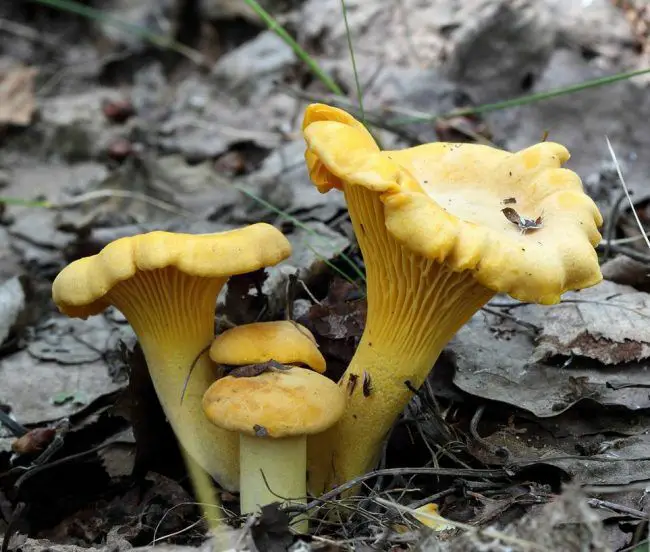
Where does it grow
Distributed in coniferous, mixed, deciduous forests, grows in families. Fruits especially well on the forest floor of coniferous and deciduous litter, moss, last year’s grass. Often found in strawberry fields.
When to Collect
The first wave of abundant growth occurs in July, the second – in August and early September. Warm rain with a thunderstorm is a signal for mushroom pickers to follow the chanterelles.
What can be confused
Cantharellus cibarius has many edible counterparts (white chanterelle, amethyst, club-shaped, tube-shaped), but there is one that is better not to take. This is a false chanterelle (Hygrophoropsis aurantiaca). It differs from the edible mushroom in a brighter and more even hat, thin and brittle orange flesh. He likes to grow on stumps, trees, and deadwood, where you will not meet a real fox.
Slippery Jack (Suillus luteus)
A chocolate-brown convex hat with a tubercle in the middle and sticky oily skin is the main feature of the Slippery Jack (Suillus luteus). From it, as well as from the “skirt” that covers the hat from below, this mushroom is easily recognized even by novice mushroom pickers. The tubular base of the oil is finely porous, similar to a sponge, at first creamy in color, in an adult mushroom it is bright yellow. The mucous membrane is slippery and easily separated from the pulp. The hat reaches a diameter of 10 cm. The pulp is juicy, and soft, in the rain, and old mushrooms are quickly saturated with moisture.
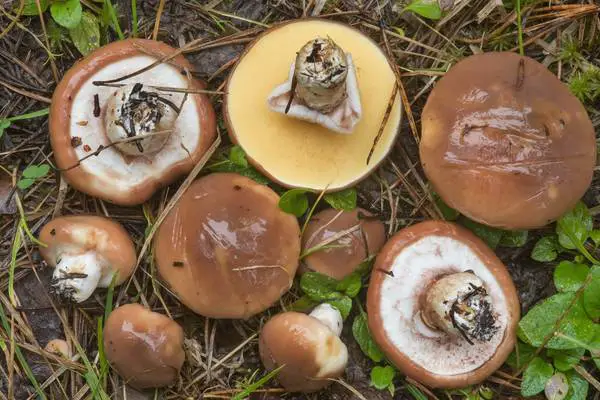
Where does it grow
Most often found in young pine plantations and spruce forests, in open clearings, edges of coniferous and mixed forests. He likes sandy soil, litter of coniferous and leaf litter.
When to Collect
Under favorable conditions, it grows from June to November, but it is especially oiled in late August – early September.
What can be confused
One of the rare mushrooms that does not have poisonous counterparts. You can confuse it with a red, granular, larch Slippery Jack, but they are all edible.
Honey mushroom (Armillaria mellea)
In good years, there are so many of them that you don’t have to “hunt”, but simply come and pick up a basket almost in one place. But this does not detract from the dignity of one of the most fragrant autumn mushrooms.
Honey mushroom (Armillaria mellea) grows not even in families, but in whole colonies, consisting of hundreds of small mushrooms on thin long legs. The hat of young mushrooms is spherical, 3-5 cm in diameter, honey-brown or yellowish-olive in color with small scales and a dark spot in the center. In adult mushrooms, it opens and becomes wavy at the edges, reaching a diameter of 10 cm.
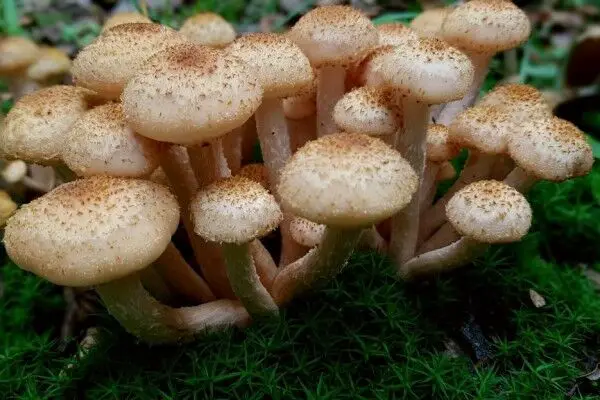
Where does it grow
They love damp places in forest lands, beams overgrown with trees, ravines, and banks of reservoirs. They grow on stumps, at the base of dead and living trees, preferably hardwoods.
When to Collect
It is best to go for autumn mushrooms from the second decade of September. Usually, they grow in 2-3 waves, each of about 15 days.
What can be confused
External resemblance (the same scales on the hat) is with dark honey agaric (Armillaria ostoyae), but it grows mainly under spruce trees. Inexperienced mushroom pickers can confuse autumn mushrooms with poisonous “false mushrooms” (Hypholoma fasciculare), which also grow on stumps, but their hat is much lighter and smoother, without scales.
saffron milk caps (Lactarius deliciosus)
Lactarius deliciosus mushrooms were served at the royal table and sent for export. Especially good when salted.
Several types of saffron milk caps are edible: real (Lactarius deliciosus), red (L. Sanguifluus), and spruce (L. Deterrimus). The camelina has a thick, shiny hat of a red, red-brown, ocher hue with characteristic concentric rings. In a young mushroom, it is flat, with curved edges; in an adult form, it forms a small funnel. Hat diameter – 3-15 cm.
The base is covered with adherent yellow-orange plates. The stem of the camelina is short, 1–2 cm thick. The flesh is dense, strong, but fragile, at the break, it releases bright orange milky juice.
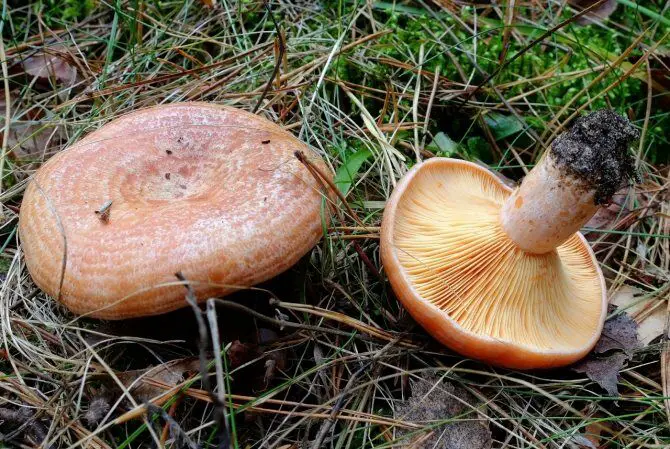
Where does it grow
In coniferous and mixed forests, most often under pine trees, along forest roadsides, or on forest edges. He likes to hide in moss, grass, and under fallen needles.
When to Collect
Massively comes out in September – the first half of October, they are harvested all autumn until the frost.
What can be confused
There is a distant resemblance to the inedible roseweed (Lactarius torminosus). It has a similar sunken cap and a lamellar base, but the volushka is much lighter and its flesh is white, with caustic white juice. You won’t get poisoned, but the taste is unpleasant.
Poisonous and Non Edible Mushrooms that Grow in Fall or Autumn
Edible mushrooms have dangerous poisonous counterparts that can cause serious poisoning.
Important! Going into the forest, you need to familiarize yourself with the description of false mushrooms. During the “silent hunt”, carefully look at which particular specimen you have caught, so as not to accidentally put a poisonous mushroom in the basket.
The most dangerous are such doubles again:
Sulphur-yellow false Mushroom
Sulphur-yellow is a poisonous mushroom with a bell-shaped hat up to 7 cm in diameter. The shade of the skin is lighter towards the edge, and in the center the hat is colored red-brown. The leg is hollow, painted in light yellow. The flesh is white or light yellow, has an unpleasant earthy smell. Unlike the edible species, the stem lacks the characteristic leathery ring.
Galerina marginata
Galerina marginata is a very dangerous poisonous counterpart that is easily confused with an edible one. Galerina is much smaller than edible specimens (the leg is no more than 5 cm long, and the cap diameter is about 4 cm). It occurs mainly in small groups on rotten coniferous wood, while real mushrooms often form large families on birch or alder.
Psathyrella Candolleana
Psathyrella Candolleana is young mushrooms, the cap is hemispherical but becomes bell-shaped with age. The fruit bodies are very brittle, and the white flesh is tasteless and odorless.
In order not to accidentally confuse a false mushroom with a real one, you need to remember the main rule: if you are not sure about the edibility of the found specimen, it is better not to take it at all. Beginners are advised to go to the forest with more experienced mushroom pickers who will tell you which mushroom is edible and which is not.
FAQ
Honey mushrooms are very popular mushrooms, but beginners may have questions regarding their collection and preparation. Below are the answers to the most popular ones.
How to distinguish a false honey mushroom from an edible one?
It is easiest to study photographs of real and poisonous species before going into the forest. But edible mushrooms can also be distinguished externally: edible autumn mushrooms have a leathery ring on the stem, and the hat is covered with scales. Poisonous specimens have a smooth cap and are painted in brighter colors.
Where do edible mushrooms grow?
Fruiting bodies are most often found on stumps and fallen trunks of birch or alder. On coniferous trees, there is a high probability of finding a false mushroom.
How to store autumn mushrooms?
They are great for frying and boiling, but most often they are marinated and salted for the winter.
How much to cook mushrooms?
Mushrooms will be fully cooked after 30-40 minutes of cooking. If the pulp is slightly undercooked, it can cause an eating disorder.
Conclusion
Since autumn or mushrooms that grow in fall grow in large groups, it is easy and pleasant to collect them. The main thing is to learn to distinguish edible species from poisonous ones, and then the harvest harvested in the forest will turn into a delicious treat for the whole family.